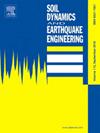The equivalent linear nature of the dynamic Soil-Foundation-Superstructure Interaction (SFSI) of bridge-piers on caisson foundations
IF 4.2
2区 工程技术
Q1 ENGINEERING, GEOLOGICAL
引用次数: 0
Abstract
This study presents a simplified approach for evaluating the Foundation Input Motion (FIM) of embedded caissons, considering the complex interaction between the caisson and the surrounding soil. The proposed solution is based on a parametric study using the finite difference code FLAC3D. The analysis explores different embedment-to-radius aspect ratios while incorporating the nonlinear response of the surrounding soil. In FLAC3D the caisson was modelled as a cylindrical element with the mechanical properties of concrete, while the soil was modelled using both a linear viscoelastic and a nonlinear constitutive model. Numerical results in the nonlinear soil regime were compared with both the proposed solution and equivalent linear numerical results, where mobilized values of soil shear modulus and damping ratio (inferred from free-field analyses) were applied. These comparisons shed light on the equivalent linear nature of the soil-caisson interaction. Additionally, several soil-caisson-bridge pier system configurations were studied in linear viscoelastic, equivalent linear, and nonlinear soil regimes. A modified version of the “substructure approach”, in which the FIM was evaluated with the proposed solution, was applied to derive the maximum acceleration of the bridge deck and the drift between the deck and the caisson and the results were compared with those obtained with FLAC3D. The results confirm that the modified “substructure approach” captures the dynamic response of soil-caisson-bridge pier systems. Furthermore, as observed in the soil-caisson interaction case, the findings support the equivalent linear nature of the soil-caisson-bridge pier interaction. The proposed solution was also compared with other methodologies available in the literature.
沉箱基础桥墩动力土-基础-上部结构相互作用(SFSI)的等效线性性质
考虑沉箱与周围土体之间复杂的相互作用,提出了一种简化的沉箱基础输入运动(FIM)评估方法。利用有限差分代码FLAC3D进行了参数化研究。分析探讨了不同的嵌入与半径纵横比,同时纳入了周围土壤的非线性响应。在FLAC3D中,沉箱被建模为具有混凝土力学特性的圆柱形单元,而土被建模为线性粘弹性和非线性本构模型。将非线性土体状态下的数值结果与所提出的解和等效线性数值结果进行了比较,其中应用了土体剪切模量和阻尼比的动员值(由自由场分析推断)。这些比较揭示了土-沉箱相互作用的等效线性性质。此外,还研究了几种土-沉箱-桥墩体系在线性粘弹性、等效线性和非线性土壤条件下的结构。采用改进版的“子结构法”,利用所提出的求解方法对桥面板的最大加速度和面板与沉箱之间的漂移进行了评估,并将结果与FLAC3D进行了比较。结果表明,修正后的“子结构法”能较好地反映土-沉箱-桥墩体系的动力响应。此外,正如在土-沉箱相互作用案例中观察到的那样,研究结果支持土-沉箱-桥墩相互作用的等效线性性质。提出的解决方案还与文献中可用的其他方法进行了比较。
本文章由计算机程序翻译,如有差异,请以英文原文为准。
求助全文
约1分钟内获得全文
求助全文
来源期刊

Soil Dynamics and Earthquake Engineering
工程技术-地球科学综合
CiteScore
7.50
自引率
15.00%
发文量
446
审稿时长
8 months
期刊介绍:
The journal aims to encourage and enhance the role of mechanics and other disciplines as they relate to earthquake engineering by providing opportunities for the publication of the work of applied mathematicians, engineers and other applied scientists involved in solving problems closely related to the field of earthquake engineering and geotechnical earthquake engineering.
Emphasis is placed on new concepts and techniques, but case histories will also be published if they enhance the presentation and understanding of new technical concepts.
 求助内容:
求助内容: 应助结果提醒方式:
应助结果提醒方式:


